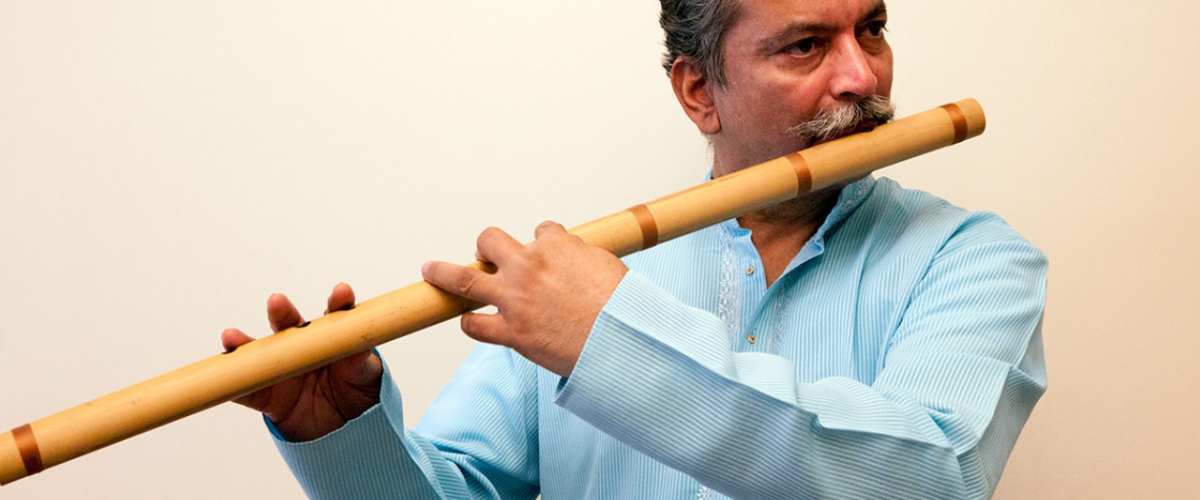

The bansuri or bamboo flute is an ancient wind instrument made of a single hollow shaft of bamboo with six or seven finger holes. Its name originates from the Sanskrit for wood, bans and the word for musical note(s), sur and is a generic term for any flute made of wood, although some are now also made of metal. Ancient Indian folklore tells of how the bamboo seemed to ‘sing’ by itself, after insects bore holes into the wood, and the wind blowing through the holes created melodies, as though by magic.
Essentially a folk instrument, the bansuri is deeply entrenched in the pastoral tradition of the cowherds of North India, most importantly as the instrument of Lord Krishna, always depicted playing the side-blown flute, also known as the murli. Lord Krishna is said to have played it with such expertise that the gopis or milkmaids of the forest of Vrindavan, where he lived, mesmerised by its sound, would leave their beds – and husbands – in the dead of night, to follow the strains of Krishna’s flute through the forest.
Krishna’s consort, Radha, is also said to be constantly under the spell of his bansuri, and in many folk songs, as well as thumris (a light classical songs) on this subject, she regards the bansuri as her chief rival in vying for Krishna’s affections. The fact that the bansuri touches his lips further intensifies her jealousy.
The instrument also has ancient connections with numerous mystical traditions and the 13th-century Persian Sufi mystic-poet Rumi likens the sound of the flute to the cry of the human, who feels separated from the Creator, just as the flute is torn away from its natural home, the bamboo reed. It is this, according to Rumi, that makes the flute sing its lament.
Although a folk instrument and also very popular for film music, the bansuri has now been an indispensable part of North Indian classical music owing mainly to maestros such as Pandit Pannalal Ghosh and Pandit Hariprasad Chaurasia, both of whom have taken this humble, pastoral instrument to giddy heights.
Ghosh, whose major innovation was the addition of the classical vocal style in flute-playing had introduced a larger form of the traditional bansuri and added extra holes for a more accurate rendering of notes in the higher octave. The South Indian equivalent of the North Indian bansuri is the venu, also made of bamboo and, again the repertoire is largely drawn from vocal music.
Listen to the music | Rakesh Chaurasia, Pandit Hariprasad Chaurasia's nephew and student, summons Raag Jog’s state of enchantment on his bansuri, elucidating fierce rhythmic lines with extraordinary breath control and tightly controlled phrases. Live from Darbar Festival 2016.
Jameela Siddiqi is an author, linguist, and BBC cultural commentator, specialising in postcolonial fiction and the devotional music of South Asia.
Darbar believes in the power of Indian classical music to stir, thrill, and inspire. Explore our YouTube channel, or subscribe to the Darbar Concert Hall to watch extended festival performances, talk and documentaries in pristine HD and UHD quality.
Could Rasa and Bhava be the bedrock of modern-day Psychology? And how does music lead to religious enlightenment?
Read More 
The name shehnai comes from the Persian word, shah meaning king, whlist nai or ney is the generic term for any kind...
Read More 
The beginner's guide to Indian classical music. Whether you’re completely new to raga music or just need a refresher, we’ve put together this brief overview of all things raga music to help you feel at ease when visiting one of our concerts or watch our videos on our YouTube or our Darbar Concert Hall.

Keep up to date with the latest news, events, music and musings across our social channels
For hundreds more clips and shorts, vist our YT page here 
Be the first to hear before events go on sale. Get the latest news and articles from Darbar